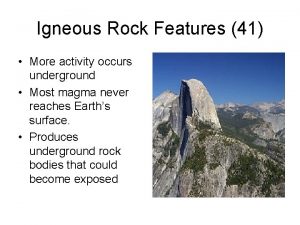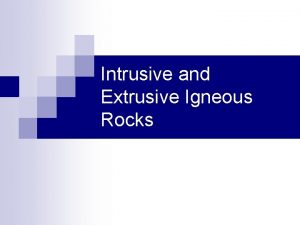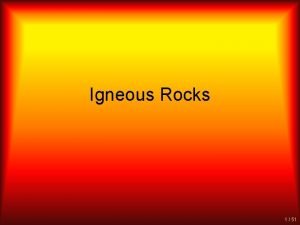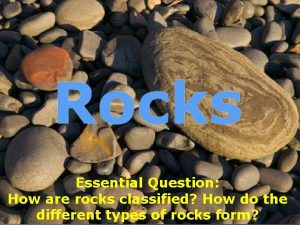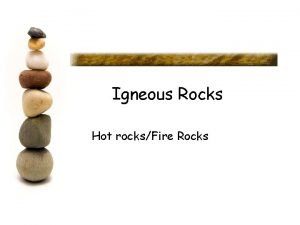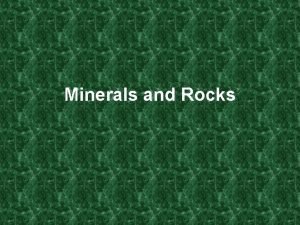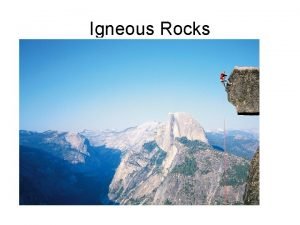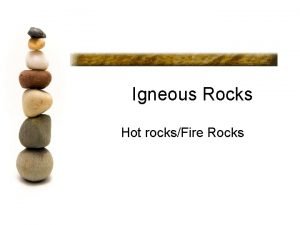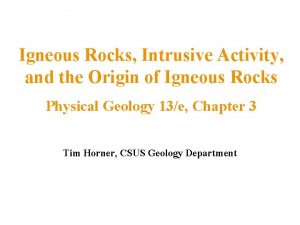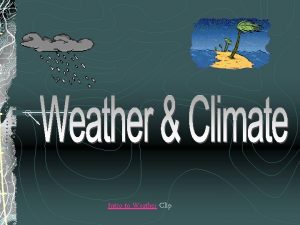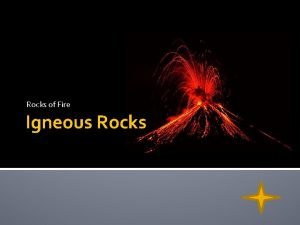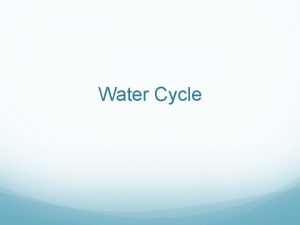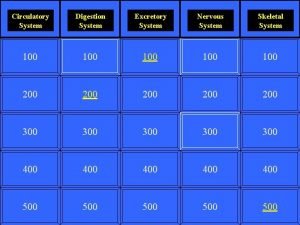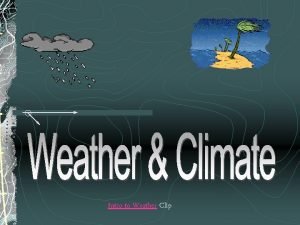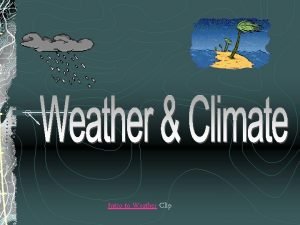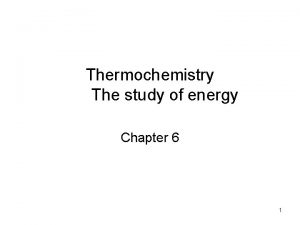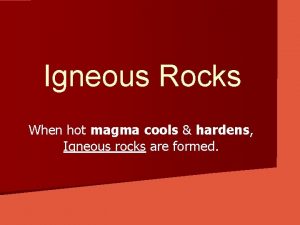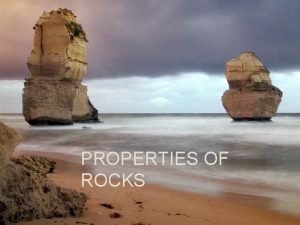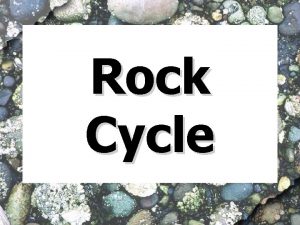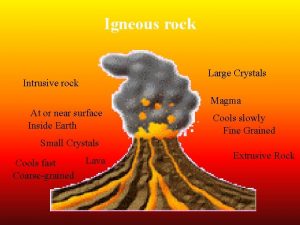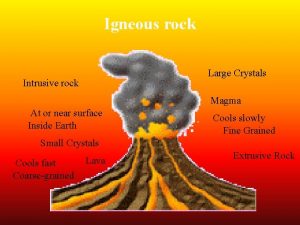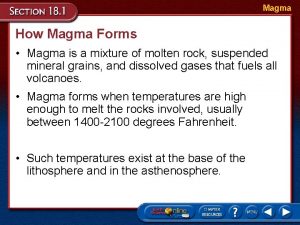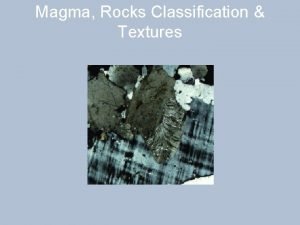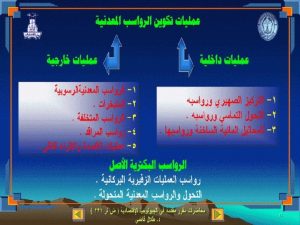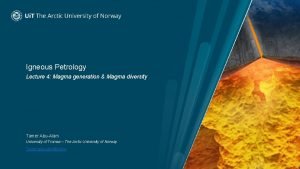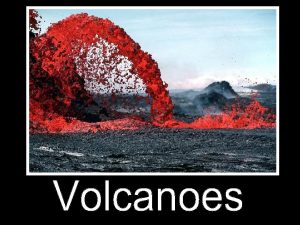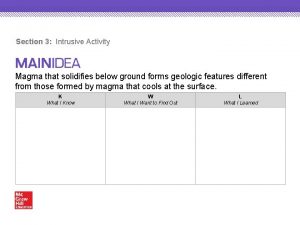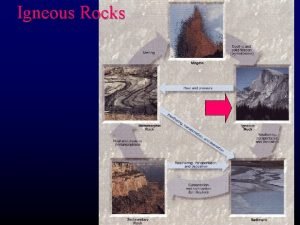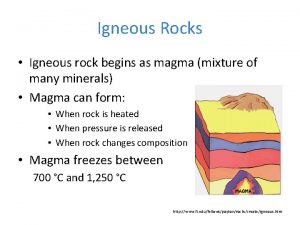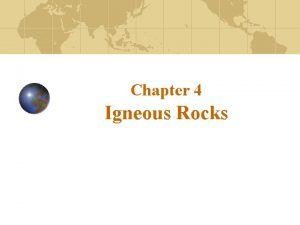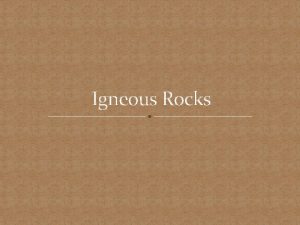Intrusive igneous activity As magma cools underground it

























- Slides: 25

Intrusive igneous activity � As magma cools underground, it will begin to solidify within Earth’s crust. � Once completely crystallized, these masses of igneous intrusive rock are referred to as INTRUSIONS or as PLUTONS � We will talk about several types of igneous plutons: › Dikes, Sills, Laccoliths, Batholiths, & Volcanic Necks

Intrusive igneous activity � Types of intrusive igneous features �Dike – relatively small igneous intrusions formed as magma penetrates into rock fractures and solidifies into thin, sheet-like bodies. �Sill – sheet-like intrusions, like dikes, but they tend to be much thicker, and form as magma intrudes in between layers of sedimentary rock, then cools. Not as common as dikes

Dike

� Diabase dike cutting thru pre. Cambrian age Hakatai Shale at Hance Rapid in the Grand Canyon.

Sill

A sill in the Salt River Canyon, Arizona

Laccolith �Begins as a sill, since material fills in between rock layers. �Because of pressure, some sills can arch up the overlying sediments, creating a mushroom shaped rock body. �Tend to form at shallow depths

Laccolith

Intrusive igneous activity � Intrusive igneous features continued �Batholith �Large plutons lacking a specific shape �Form as huge quantities of magma intrude into country rock, remove fragmets, and melt their way towards the surface. �Most remains underground �Large batholiths can be over 100 miles across

� When batholiths are uplifted and exposed, they are usually resistant strata that form the roots of mountain ranges or eroded highlands.

Batholiths of western North America

Batholith

Intrusive Igneous Activity � Volcanic pipes and necks �Pipes - short conduits that connect a magma chamber to the surface �Volcanic necks (e. g. , Ship Rock, New Mexico) - resistant vents left standing after erosion has removed the volcanic cone

Formation of a volcanic neck

The most famous volcanic neck in the United States is Shiprock, New Mexico


Igneous Intrusions

Volcanoes & Plate Tectonics � Most volcanoes occur in the area known as the Ring of Fire � Volcanoes can form at CONVERGENT & DIVERGENT plate boundaries!! � Volcanoes can also occur within a plate which can result in hot spots and form Island chains like Hawaii & Iceland

� A. Rising mantle plume; B. Rapid decompression melting producing flood basalts; and C. Rising plume tail produced by linear seafloor volcanic chain

Distribution of some of the world’s major volcanoes

Volcanoes and climate � The basic premise �Explosive eruptions emit huge quantities of gases (SO 2) and fine-grained debris �A portion of the incoming solar radiation is reflected and filtered out � Past examples of volcanism affecting climate �Mount Tambora, Indonesia – 1815 �Krakatau, Indonesia – 1883

Volcanoes and climate � Modern examples �Mount St. Helens, Washington - 1980 �El Chichón, Mexico - 1815 �Mount Pinatubo, Phillippines - 1991

Pinatubo Eruption June 1991 � Map showing areal distribution of pyroclastic flows of June 1991 and destructive lahars that ensued in September 1991, killing many more people than the eruption

� Sulfer dioxide emissions of large volcanic eruptions from 1979 -91, in thousands and millions of tons

� Impact of SO 2 emissions on global climate, caused by formation of H 2 SO 4 aerosol, deflecting radiant energy from the Sun into the Stratosphere
 Extrusive igneous rocks
Extrusive igneous rocks Underground igneous rock bodies are called
Underground igneous rock bodies are called Pumice extrusive or intrusive
Pumice extrusive or intrusive The formation of igneous rocks
The formation of igneous rocks Intrusive igneous rocks examples
Intrusive igneous rocks examples Venn diagram of intrusive and extrusive igneous rocks
Venn diagram of intrusive and extrusive igneous rocks How igneous rocks are formed
How igneous rocks are formed Types of rocks metamorphic
Types of rocks metamorphic Intrusive igneous rocks texture
Intrusive igneous rocks texture Igneous rocks
Igneous rocks Igneous rocks
Igneous rocks Igneous rock
Igneous rock Concept map on types of rocks
Concept map on types of rocks Jurgen cools
Jurgen cools Brainpop1
Brainpop1 Metamorphic rock defintion
Metamorphic rock defintion This precipitation gathers into
This precipitation gathers into Sweating cools the body through _____.
Sweating cools the body through _____. Brainpop weather
Brainpop weather Energy bar diagram
Energy bar diagram An iron bar of mass 869 g cools from
An iron bar of mass 869 g cools from What happens when the temperature of the air cools brainpop
What happens when the temperature of the air cools brainpop Heat flowing out of earth as it cools is one form of
Heat flowing out of earth as it cools is one form of How much heat is given off when an 869 g iron bar cools
How much heat is given off when an 869 g iron bar cools What single factor controls humidity
What single factor controls humidity Gypsum rock type
Gypsum rock type

